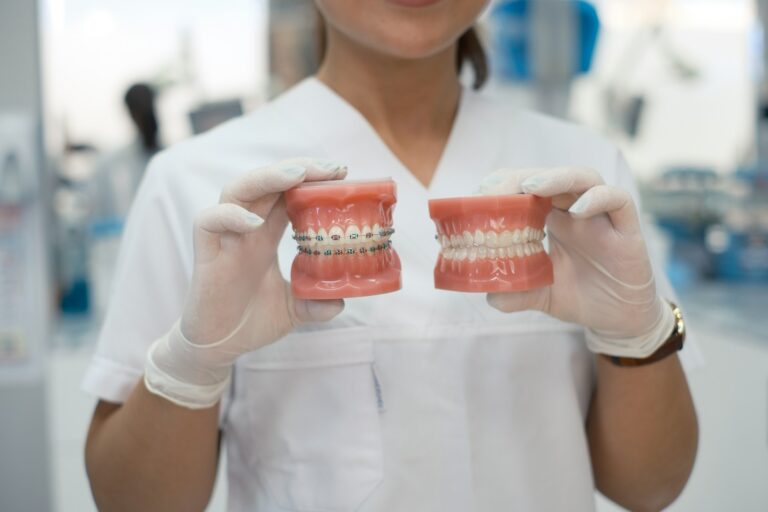What Is An Orthodontist? What Do They Do?

Do you want a smile that lights up any room? Orthodontics might be your answer. More than just straight teeth, orthodontics plays a crucial role in dental health and overall well-being. Whether you’re a parent considering braces for your child, an adult wanting to perfect your smile, or a teen curious about clear aligners, you’re in the right place.
Let’s talk about what is an orthodontist and why orthodontic care is essential for you and your loved ones.
What is an Orthodontist?
An orthodontist is a dental specialist who focuses on diagnosing, preventing, and treating dental and facial irregularities.
Unlike general dentists, who manage overall dental care, orthodontists receive additional training to correct misaligned teeth and jaws.
Think of them as the architects of beautiful smiles, equipped with the expertise to straighten teeth, fix bites, and guide jaw growth.
The Importance of Orthodontics in Dental Health
Orthodontic treatment isn’t just about aesthetics.
Misaligned teeth can lead to various health issues, including gum disease, tooth decay, and difficulties in chewing and speaking. Properly aligned teeth are easier to clean, reducing the risk of oral diseases.
Additionally, correcting jaw alignment can alleviate problems like TMJ disorders and chronic headaches, making orthodontics a vital aspect of maintaining overall health.
Education and Training of an Orthodontist
Becoming an orthodontist requires a significant amount of education and training. First, aspiring orthodontists must complete a bachelor’s degree, often in a science-related field.
Following this, they attend dental school, earning either a Doctor of Dental Surgery (DDS) or Doctor of Dental Medicine (DMD) degree. But the journey doesn’t end there.
After dental school, orthodontists undergo an additional 2-3 years of specialized training in an orthodontic residency program. This advanced training focuses on the intricacies of tooth movement, facial development, and corrective procedures.
Orthodontists must also pass rigorous exams to become board-certified, ensuring they meet the highest standards of practice.
What Does an Orthodontist Do?
Orthodontists begin by conducting comprehensive evaluations, including X-rays, photographs, and digital scans, to diagnose dental and facial irregularities.
Based on these assessments, they develop personalized treatment plans to address each patient’s unique needs.
Use of Braces, Aligners, and Other Corrective Appliances
Orthodontists employ various tools to correct misalignments, including traditional braces, clear aligners (such as Invisalign), and other appliances like palate expanders.
These devices work by exerting gentle pressure to shift teeth into their proper positions over time.
Monitoring Patient Progress and Adjusting Treatments
Orthodontic treatment is a dynamic process that requires regular monitoring. Orthodontists schedule periodic check-ups to evaluate progress and make necessary adjustments to ensure optimal results.
These visits are crucial for tracking improvements and addressing any concerns promptly.
Common Procedures in Orthodontics
Orthodontists use their expertise to correct a wide range of dental and facial irregularities. Some of the most common procedures include:
- Braces: The traditional method for correcting misaligned teeth, braces consist of metal or ceramic brackets attached to the teeth and connected by wires.
- Clear Aligners: Made from clear plastic material, aligners are virtually invisible and can be easily removed for eating and cleaning.
- Retainers: After completing orthodontic treatment, patients typically wear retainers to maintain their newly aligned teeth.
- Jaw Surgery: In severe cases of misalignment, orthodontists may refer patients to oral surgeons for corrective jaw surgery.
- Palate Expanders: These devices are used to widen the upper jaw to create more space for crowded teeth.
When to See an Orthodontist?
Orthodontic problems can occur at any age, but it’s best to visit an orthodontist during childhood for early detection and treatment.
The American Association of Orthodontists recommends children receive their first orthodontic evaluation by the age of 7. However, orthodontic treatment is not limited to children; adults can also benefit from corrective procedures at any time.
Indicators for Needing Orthodontic Treatment
Knowing when to consult an orthodontist can be crucial for timely intervention. Common signs include crowded or spaced teeth, difficulty biting or chewing, jaw pain, and speech difficulties.
If you notice these issues in yourself or your child, it’s time to schedule a consultation.
Adult Orthodontics
More adults are turning to orthodontic treatment to achieve the smiles they’ve always wanted. With advancements in clear aligners and less noticeable braces, it’s easier than ever for adults to improve their dental health and appearance discreetly and effectively.
Benefits of Orthodontic Treatment
Orthodontic treatment offers numerous benefits for patients of all ages, including:
- Improved dental and facial aesthetics
- Better oral hygiene and reduced risk of cavities and gum disease
- Enhanced chewing and speaking abilities
- Reduced risk of jaw pain, headaches, and TMJ disorders
- Boosted self-esteem and confidence
Finding the Right Orthodontist for You
Choosing an orthodontist is a significant decision, and it’s essential to find one you trust. Consider factors such as experience, credentials, treatment options offered, and patient reviews when making your selection.
It’s also crucial to schedule consultations with multiple orthodontists to discuss your concerns and determine which one aligns best with your needs.
Orthodontic care is an investment in your dental health and overall well-being. Whether you’re looking for traditional braces or clear aligners, an orthodontist can help you achieve the healthy, beautiful smile you deserve.
Conclusion
Understanding orthodontic care is vital for maintaining optimal dental health and achieving a beautiful smile. So, what is an orthodontist? An orthodontist is a highly trained dental specialist dedicated to diagnosing, preventing, and treating dental and facial irregularities.
Their expertise with braces, aligners, and other corrective appliances plays a crucial role in improving oral functionality and aesthetics. By consulting a qualified orthodontist, you can ensure that you receive personalised treatment tailored to your unique needs.
Now that you know what an orthodontist does, you can book a free consultation with us at Superior Care Orthodontics. Our expert team, led by Dr. Robert J. Herman, is here to guide you on your orthodontic journey, offering personalized care and advanced treatments.

